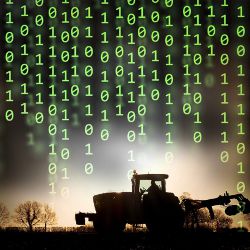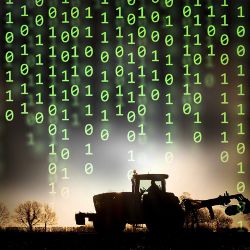
In a world with more mobile phones than flush toilets, digital devices are now standard equipment among even the world’s poorest and most remote people. Farmers in these areas are getting tools for their devices that help deliver water, nutrients, and medicine to plants as needed; test for crop diseases and malnourishment; and survey their soil for future planning. In some cases, these emerging apps are the biggest new technologies resource-poor farms have seen in hundreds of years.
That is not very surprising to Rajiv “Raj” Khosla, professor of Precision Agriculture at the College of Agricultural Sciences of Colorado State University. “What we’re finding is that many small-scale farmers in resource-poor environments are still farming in the 1500s. They’re looking for leapfrog technologies,” he said.
Founder and past president of the International Society of Precision Agriculture, Khosla described how data and modern techniques can multiply yields through small changes. “I was involved in a study in the northwestern part of India where a farmer had two acres of land,” he said. “They divided it into two halves. They precision-leveled one side [using GPS] and they did conventional leveling of the other [using a wooden plank and oxen]. On the precision-leveled side, they also sampled the soil for balanced nutrition, and instead of flooding the entire field when water was available, they only flooded it every other time, so using 50% less water. Same crop, same variety, same size, and guess what? On the “conventional” side, the farmer produced 800 kilos of wheat; on the other half, they harvested 2,250 kg.”
Precision agriculture also guides farm machinery based on satellite images, GPS information, or local surveys. John Nowatzki, agricultural machine systems specialist at North Dakota State University, described how precision “side-dressing” of fertilizer benefits farmers over the traditional method of blanketing the entire field. “First, farmers lower their costs by being more efficient in their use of their fertilizer. Second, you could put a no-spray zone in over an ecologically sensitive area, such as a waterway, so it’s an environmentally friendly technology as well.”
From the Soil to the Sky
Yield improvements mean a lot locally to the individual farmer. However, such improvements come from a global effort that incorporates both satellite data and decades of on-the-ground surveys.
One example is soil research, which guides individual farmers on what to grow and how to treat the soil. “Soil surveys can and should be used for agricultural, land development, and conservation decisions affecting more than a couple of acres” said Dylan Beaudette, a soil scientist for the National Resources Conservation Service (NRCS), which makes U.S. soil conditions available via apps, websites, and a JavaScript Object Notation (JSON) interface. “They’ve gone from loosely coordinated local efforts to nation-wide scientific investigations,” he said. “These changes reflect our continuously changing understanding of—and expectations from—soil research.”
The International Soil Reference and Information Centre (ISRIC) in the Netherlands manages similar data worldwide, recently producing soil maps for the Africa Soil Information Service (Af-SIS). ISRIC’s data for this project was predictive, applying a “random forest data mining algorithm on the input data to achieve 250-meter resolution.
“We discovered that machine learning is well suited for soil data,” ISRIC senior researcher Tomislav Hengl said. “Most likely this is because we model the soil variable as a function of climate, relief, geology, and vegetation dynamics. In most cases, this relationship is nonlinear, so when you use machine learning techniques, you have a better chance to discover the nonlinear relationships.”
The Plant Itself
Once a plant pushes its way above the soil, farmers can scan it using hyperspectral imaging, which examines its appearance for disease and malnutrition under several specific wavelengths of light. According to Simon Holland, CEO of agricultural technology company Barefoot Lightning, the technique works well from a variety of vantage points. “You’ve got your satellites looking from a great distance, with maybe one- to three-meter resolution on the ground,” he said, “and you’ve got a drone with similar equipment doing nutrient analysis and looking for two or three disease signals. Then on the ground, there are devices that can recognize a disease because the chlorophyll signal’s gone off track. But they’re still doing a point analysis, not a full image analysis of a leaf or any other structure.”
For a closer look, Holland’s company has partnered with the University of Manchester’s e-Agri Sensors Centre to develop a handheld hyperspectral imager. Besides providing diagnoses unavailable to cameras far above the crops, such devices could also be far less expensive. Centre director Bruce Grieve explained, “Cameras in an aircraft or satellite are high-cost because the only light available to them is sunlight. You need a sensitive detector because the system filters out 99.9% of the energy to keep only the very narrow bands that you’re trying to get,” he said. “But if you go close up, you can do narrow-band illumination using LEDs, and read the signals with a standard CMOS detector that might be in a mobile phone.”
Those images are compared against disease libraries held in the phone for a diagnosis; then, said Holland, “If we come up with something we don’t recognize, we could send a sample to a lab for more-detailed spectra and to do a pathology assessment on the scanner’s ‘big brother’ device. That way, you can also start doing a big-data collection for the disease database.”
Even the process of collecting those samples can be challenging in low-resource areas, where transportation and temperature control are harder to come by. One simple solution is found in the lab of Ratmir Derda, assistant professor in the Department of Chemistry at the University of Alberta: a sort of paper Petri dish. “Even in North America, you can be a half-day’s travel from the nearest lab. In the field you don’t have incubators, or an aseptic environment, or other things that you’d find in a clinical laboratory. So we’re trying to package the sample in a device that’s aseptically sealed, that can be easily inoculated with a sample, and is lightweight enough to maintain the desired temperature for transport or growth without much energy.”
A somewhat more technical solution comes from the University of Wisconsin, where associate professor of biochemistry Douglas Weibel has developed a “cartridge” containing all the chemistry and fluid-handling capabilities needed to perform in-field analyses, delivering results to a mobile phone via a USB cable connected to a small electronic reader. “To test a cassava crop for five to 10 different viruses, we create a ‘cassava chip’ in which all of the reagents are pre-loaded on the small cartridge, which is vacuum-sealed in a disposable Mylar bag,” he said. “Your phone guides you through all the steps. You open the bag, take the chip out, suck up a small amount of sample, and put the chip in the reader, which heats the assays up for 15 minutes. The reader performs a one-wavelength scan with inexpensive LEDs and a low-cost CMOS camera. It could be multispectral; however, the goal was to keep it simple.”
Food and Finance
These technologies are only helpful if low-resource farmers can overcome barriers of cost and location to access them. Weibel hopes eventually to bring his assay readers to developing countries for under $50, with the price on specific chips below 50 cents. However, he says, that means approaching a larger, higher-margin market first. “We have a two-stage model,” said Weibel. “The first stage is commercialization in a place like North America that can drive research and development to create the platform. Then in the second stage, once we have scalability figured out, we adapt the technology to problems in sub-Saharan Africa. Those problems are likely to be quite different from the agricultural challenges here. Economics also plays an important role. In the U.S., it is possible to eradicate an entire crop to prevent spread, however this strategy would bankrupt farmers in developing countries.”
The $50 cost for the assay reader could be out of reach in these areas, particularly to “smallholder” farmers, Weibel said, “But the beauty is that a technology like this could stimulate a business model whereby someone invests money in buying one of these test systems, and provides the route to distribution by performing tests for farmers at a low cost.”
Khosla pointed out farm size would also encourage such a “service provider” model. “I might have 10 farmers come to my field day [in Colorado], each with 2,000–10,000 acres they’re farming, for a total of 50,000 acres,” he said, “but 50,000 acres in south Asia means thousands of farmers!”
Developing a network of providers to service all those farmers is likely to be at least as big a challenge as perfecting the technology. As the technologies improve—and costs drop—some of the tools will eventually come into individual farmers’ hands. Speaking of his hyperspectral imaging device, Grieve said, “We’re looking at actually putting it in peoples’ pockets, so a farmer who wants to check some feature on a crop can just pop the thing in and see what’s actually happening.”
Further Reading
Pongnumkul, S., Chaovalit, P., and Surasvadi, N. (2015).
Applications of Smartphone-Based Sensors in Agriculture: A Systematic Review of Research. Journal of Sensors, 2015.
Hengl, T., Heuvelink, G. B., Kempen, B., Leenaars, J. G., Walsh, M. G., Shepherd, K. D., and Tondoh, J. E. (2015).
Mapping soil properties of Africa at 250 m resolution: Random forests significantly improve current predictions. PloS one, 10(6), e0125814.
Derda, R., Gitaka, J., Klapperich, C. M., Mace, C. R., Kumar, A. A., Lieberman, M., and Yager, P. (2015).
Enabling the Development and Deployment of Next Generation Point-of-Care Diagnostics, PLOS Negelected Tropical Diseases, http://bit.ly/1PnG40F.z.






Join the Discussion (0)
Become a Member or Sign In to Post a Comment